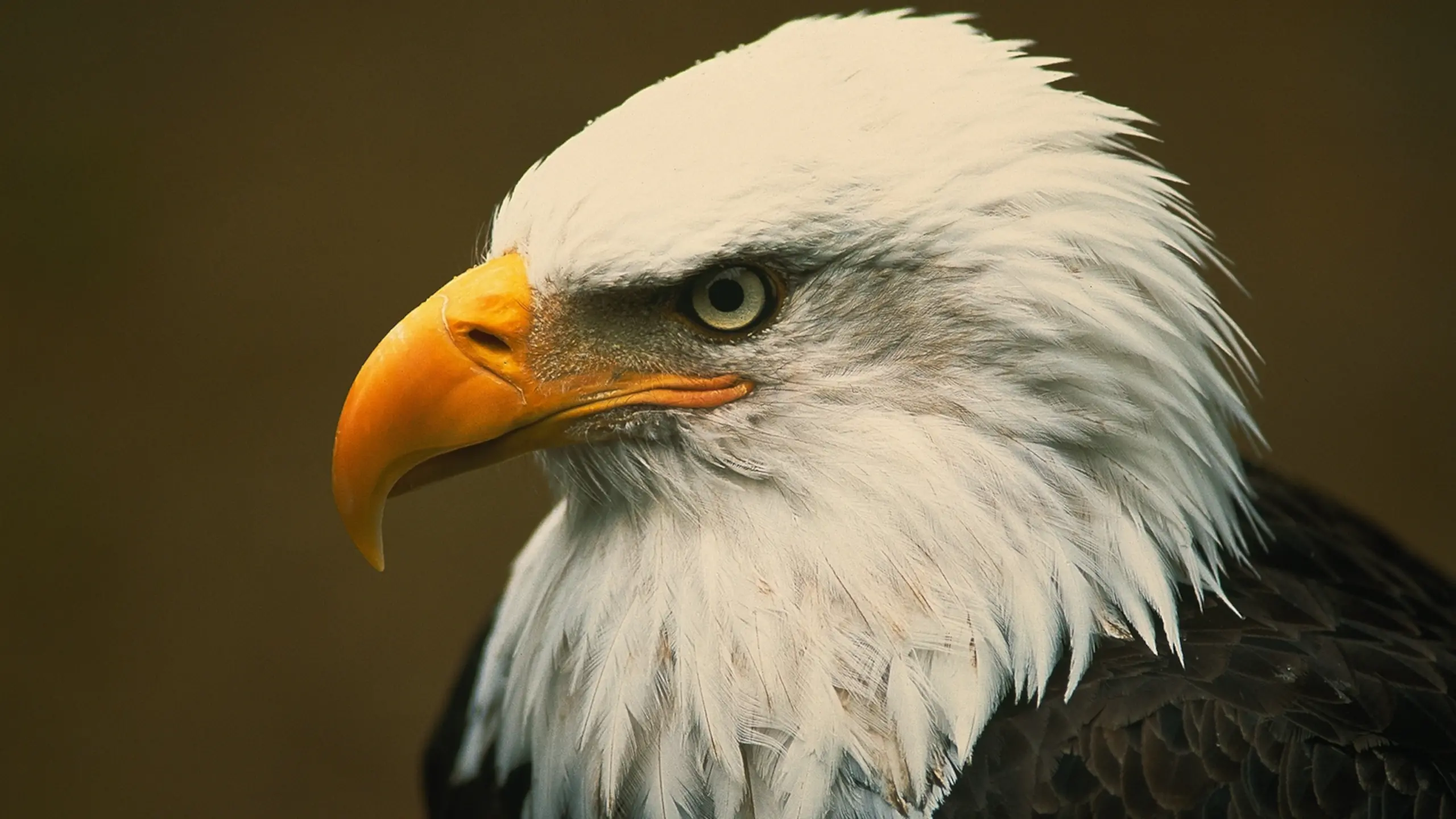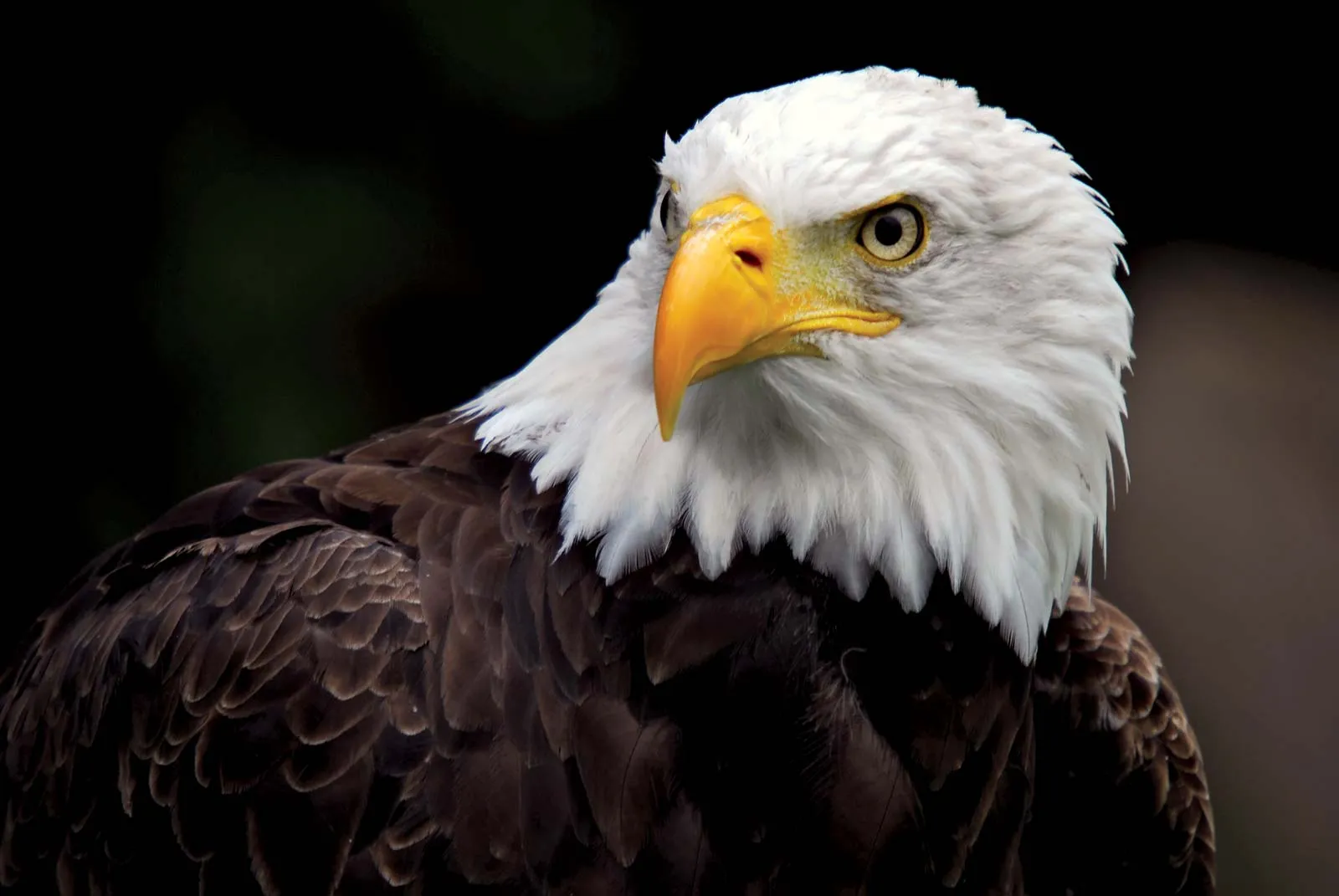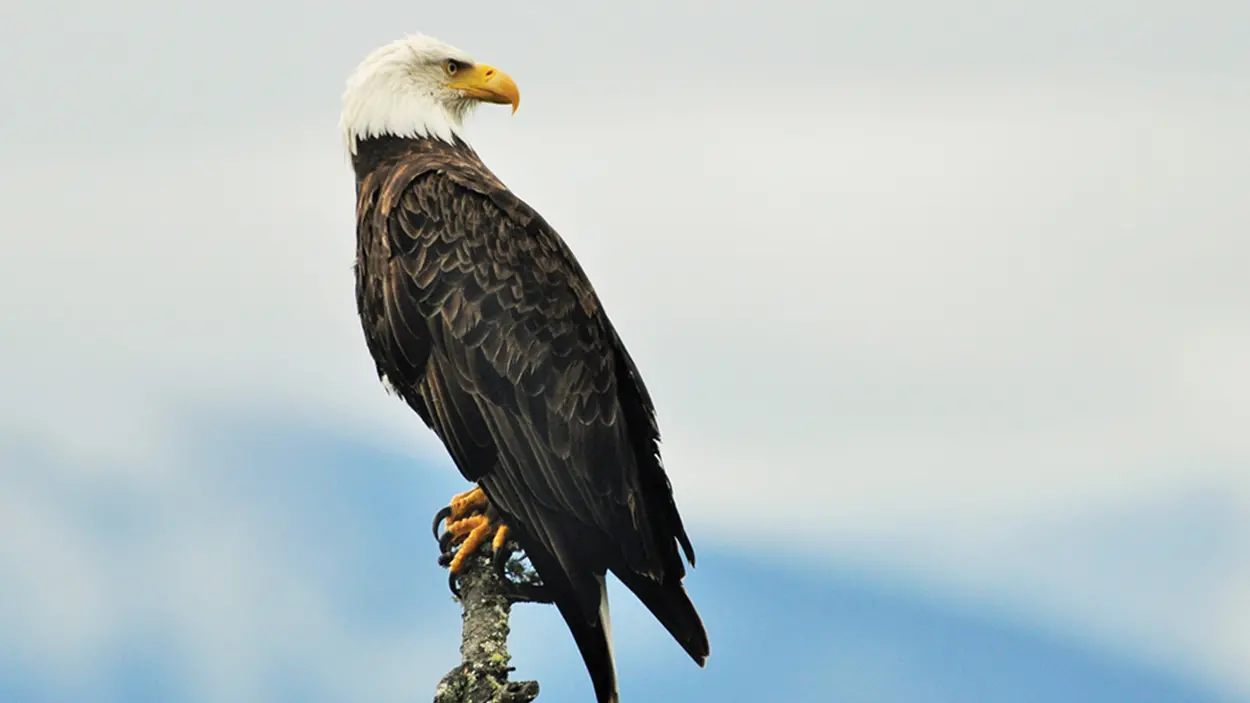American Bald Eagle: Description, Habitat, Behavior, and Conservation
The American Bald Eagle (Haliaeetus leucocephalus) is not just a bird; it’s a symbol of freedom, strength, and resilience deeply embedded in the cultural fabric of the United States. Recognized for its iconic white head and tail contrasted against a rich brown body, the Bald Eagle soars majestically across North America’s skies. As the national bird and symbol of the United States, it encapsulates the spirit of the nation, representing the ideals of independence and the American spirit. Throughout history, this magnificent bird has fascinated people, inspiring tales and fostering a sense of pride among Americans. From the smallest streams to the expansive coastlines, the Bald Eagle commands the skies above, embodying grace and power, and reminding us of the importance of conservation efforts aimed at preserving not just wildlife, but the very essence of our natural heritage. In this piece, we will delve into the various attributes and significance of the American Bald Eagle, exploring its biological characteristics, habitat, behavior, and its profound role in culture and conservation.

Description and Identification
The American Bald Eagle is undeniably one of nature’s most remarkable raptors, exhibiting features that make it both easily recognizable and captivating. With a wingspan extending up to 2.3 meters (7.5 feet) and a body length measuring between 70 to 96 cm (27.9 to 37.8 inches), this bird commands attention as it soars overhead. Think of it as a living emblem; when its wings stretch wide against the backdrop of a blue sky, it symbolizes the vastness of American landscapes.
Adult Bald Eagles are characterized by their dark brown feathers covering the body and wings, sharply contrasting with a brilliant white head and tail. Their beaks are bright yellow and large, giving them a regal appearance that is further emphasized by their formidable talons designed for hunting. Juveniles, in contrast, appear quite different, sporting a mottled brown plumage that lacks the defining white features of adulthood. The transformation to mature coloration typically takes around four to five years, illustrating a powerful metaphor for growth and evolution. It’s as if each stage of their life tells a different story about resilience and adaptation as they navigate the complexities of their environment.
Visual Identification Summary:
| Feature | Adult | Juvenile |
|---|---|---|
| Body Color | Dark brown with white head and tail | Varying shades of brown with white mottling |
| Size | 70-96 cm (27.9-37.8 inches), wingspan 1.8-2.3 m (6-7.5 feet) | Similar size, but plumage differs significantly |
| Beak | Bright yellow, powerful | Yellow but less vivid |
| Recognition | Prominent white head and tail | Mottled appearance, less distinct |
Ultimately, the striking features of the American Bald Eagle make it a captivating spectacle whether soaring high over the landscape or perched gracefully on a tree branch. Its presence evokes feelings of admiration and marvel, inviting a closer look at the majesty of nature.
Physical Characteristics
When discussing the physical characteristics of the American Bald Eagle, it’s essential to appreciate the details that contribute to its formidable persona. Adult Bald Eagles embody graceful power, with a robust and powerful frame that enables them to excel as apex predators.
- Size: Adult Bald Eagles range from approximately 70 to 96 cm in length (27.9 to 37.8 inches), with males typically being slightly smaller than females. Males can weigh between 3 to 6.3 kg (6.6 to 14 lbs), whereas females tend to weigh more, often reaching up to 6.5 kg (14.3 lbs) or more. The wingspan is equally impressive, stretching from 1.8 meters to 2.3 meters (6 to 7.5 feet), giving them the ability to soar gracefully across vast expanses of sky.
- Coloration: The contrast between the dark brown body and the striking white head and tail is nothing short of breathtaking. As they mature, their plumage shifts from a more muted tone typical of juveniles to the distinctive white that heralds adulthood. The vibrant yellow bill and sharp talons further enhance this bird’s commanding appearance; these adaptations are not merely for beauty but serve crucial hunting functions. Eagle-associated phrases often liken them to “living symbols” a metaphor for their role in the avian kingdom and vice versa.
- Unique Adaptations: Eagles possess exceptional adaptations related to their hunting lifestyle. Their eyesight is estimated to be 4 to 8 times better than that of humans, allowing them to spot prey from great distances. Imagine a binocular view brought to life this keen vision equips them for spotting fish and other animals from high above, as though they possess a built-in radar system.
- Distinctive Features: Some identifying features include their large size, the pronounced yellow bill, and the bold contrast of their feathers. Along with these physical attributes, observing how they fly reveals further clues Bald Eagles typically hold their wings flat while soaring, and their large heads extend slightly ahead of their wings, providing them a streamlined silhouette.
In summary, the physical characteristics of the American Bald Eagle combine intricacy and dynamism, representing an evolutionary marvel of nature. Their majestic appearance illustrates how form meets function, giving rise to an apex predator that commands respect and awe wherever it is spotted.
Age and Lifespan
The age and lifespan of the American Bald Eagle are remarkable indicators of both their inherent resilience and the varied ecosystems in which they thrive. These traits set the Bald Eagle apart as a symbol of endurance and strength in the wild.
- Maturity: Typically, Bald Eagles reach sexual maturity between the ages of 4 and 5 years. This period marks a significant transformation; they undergo a series of changes in plumage that reflect their growth and adaptation to their environment. After fledging, young eagles experience several years of development, leading to considerable variations in appearance before achieving the distinctive adult plumage.
- Lifespan: In terms of longevity, Bald Eagles are known to live up to 38 years in the wild, a testament to their ability to adapt to a fluctuating environment filled with both predators and challenges. For example, a banded Bald Eagle was recorded as being 38 years old at the time of its death in 2015. This long lifespan often allows them to have several breeding seasons, contributing to their population stability.
- Mortality Rates: However, it is crucial to consider the challenges faced by young eagles. Approximately 50% of eaglets do not survive their first year due to various environmental and predation-related factors. This statistic underlines the harsh realities of nature and the inherent struggle for survival similarly echoed in narratives of wilderness and survival that permeate literature and folklore.
- Captive Lifespan: Interestingly, Bald Eagles tend to live significantly longer in captivity, with lifespans extending beyond 50 years. The absence of threats such as predators, food scarcity, and environmental hazards allows these magnificent birds to enjoy extended lives under the careful watch of wildlife rehabilitation facilities.
Ultimately, the age and lifespan of the Bald Eagle illustrate a narrative of tenacity and adaptation. Just as each cycle in nature tells a unique story, so too does the life of a Bald Eagle unfold a poignant reminder of the fragility and magnificence of life in the wild.
Distinctive Features of Adults and Juveniles
The distinguishing features of adult and juvenile Bald Eagles present an intriguing look at the life stages of this magnificent species. Understanding these differences allows birdwatchers and nature enthusiasts to recognize and appreciate the varying stages of development exhibited by these impressive avians.
- Adults vs. Juveniles:
- Adults: Adult Bald Eagles sport a remarkable appearance. Their body feathers have a rich, dark brown coloration, sharply contrasted by pristine white feathers on the head and tail. The adult’s bill and feet are bright yellow, exuding a regal quality. The generally uniform and striking features of adults make them symbols of power and majesty, reminiscent of a king surveying its domain. They tend to be larger than juveniles and usually weigh between 3 to 6.3 kg (6.6 to 14 lbs).
- Juveniles: Juvenile Bald Eagles, in stark contrast, do not exhibit the iconic white feathers until they reach about four to five years of age. Initially, they present a predominantly dark brown appearance with varied degrees of white mottling, particularly on their wings and tail. This coloration serves as camouflage, allowing young eagles to avoid detection by predators.
Visual Comparison Summary:
| Feature | Adult | Juvenile |
|---|---|---|
| Coloration | Dark brown body, white head/tail | Dark brown body, mottled wings/tail |
| Size | Larger (3-6.3 kg, 70-96 cm) | Smaller, similar body weight |
| Bill and Feet Color | Bright yellow | Yellow, less vibrant |
| Age until Distinctive Plumage | 4 to 5 years | Under 4 years |
Like a coming-of-age narrative, each life stage of the Bald Eagle represents a phase of maturation and adaptation to a complex world. The transformative journey from a mottled juvenile to a regal adult reflects the challenges of survival and the impressive beauty inherent in nature.
Habitat and Distribution
The habitat and distribution of the American Bald Eagle are crucial to understanding the dynamics of their life and the factors influencing their population. This majestic bird primarily prefers environments rich with open water bodies where it can hunt and feed.
- Open Water: Bald Eagles are often found near large bodies of open water, including lakes, rivers, and coastal areas, that serve as their primary hunting ground. These waterways offer not only a rich supply of fish but also essential nesting sites in the form of tall trees near the shorelines.
- Year-Round Presence: In North America, Bald Eagles are widely distributed. Populations exist from the southern borders of Alaska down through the contiguous United States, where they have adapted to various ecological niches. Particularly high populations are observed in states like Alaska and along the coasts, such as in the Chesapeake Bay.
Distribution Summary:
| Region | Description |
|---|---|
| Alaska | Year-round residents; high populations due to abundant food sources |
| Continental U.S. | Winters migrants from northern habitats seeking open water |
| Coastal Areas | Prefer nesting near coastline, utilizing marine resources |
| Forested Areas | Nesting preference for large trees, often near water bodies |
Through winter, Bald Eagles congregate around unfrozen lakes and rivers, a scene reminiscent of a gathering of noble birds at a royal banquet. This fascinating behavior emphasizes their dependence on healthy aquatic ecosystems and the surrounding habitats for survival and reproduction. Each geographic area they inhabit contributes uniquely to their lifecycle, reflecting an intricate balance of nature that highlights the importance of protecting these vital ecosystems.
Preferred Environments
The preferred environments of the American Bald Eagle are a direct reflection of their evolutionary adaptations and their need for survival. This bird has finely tuned its habitat preferences to maximize its hunting and breeding success.
- Nesting Habitats: Bald Eagles typically build their nests, known as aeries, in tall, sturdy trees that offer a clear view of the surrounding area. Preferred species for nesting include coniferous trees like pines and spruces. The height ensures safety from ground predators and provides proximity to water sources for hunting, creating a vital junction for food availability and safety.
- Territorial Behavior: These birds exhibit strong territorial behavior, especially during breeding seasons when they defend their nesting areas vigorously. The ideal nesting site must also balance factors such as distance from human disturbance, availability of food sources, and height for security against potential predators.
Preferred Environment Summary:
| Feature | Description |
|---|---|
| Nesting Sites | Tall, sturdy trees (pines, spruces) |
| Proximity to Water | Closeness to lakes, rivers, and coastal areas |
| Ideal Conditions | Minimal human disturbance; open space for hunting |
In summary, the Bald Eagle thrives in environments that embody an equilibrium between hunting and nesting. By protecting these critical habitats, we not only ensure the continuation of this iconic species but also sustain the ecological balance essential for the overall health of our natural landscapes.
Geographic Range Across the United States
The geographic range of the American Bald Eagle extends impressively across North America, with populations spread throughout the continental United States and Canada. This extensive habitat use highlights their adaptability and resilience to various environments.
- Southerly Migration: Bald Eagles that breed in northern regions, particularly Canada and Alaska, migrate south during winter, seeking open water and abundant food supplies. They often return to the same wintering and breeding grounds each year, showcasing strong loyalty to established habitats.
- Habitat Highlights: Key regions where Bald Eagles thrive include diverse ecosystems such as the wooded shores of the Great Lakes, coastal wetlands along the Gulf and Atlantic coasts, and the river systems that crisscross the heart of the U.S.
Geographic Distribution Summary:
| Area | Characteristics |
|---|---|
| Alaska | Permanent residents, high population density |
| Great Lakes | Abundance of food and nesting habitats |
| Southern States | Migratory destinations during winter months |
| Coastal Regions | Ideal nesting and feeding grounds |
In total, the Bald Eagle’s range is a testament to its adaptability and determination to thrive in various climatic and ecological conditions. By preserving their natural landscape, we support the resilience of one of America’s most enduring wildlife symbols.
Seasonal Migration Patterns
The migration patterns of the American Bald Eagle are remarkable, driven largely by seasons and the availability of food and suitable habitat. These patterns illustrate the bird’s adaptability and keen awareness of environmental cues.
- Winter Migrations: During the colder months, Bald Eagles migrate from their northern breeding grounds in Canada and Alaska to southern parts of the United States. This migration is primarily motivated by the search for open water; eagles need unfrozen bodies to access their main food source fish.
- Return Journey: As spring approaches and the days grow longer, Bald Eagles instinctively return to their northern territories. This migration is timed with environmental signals such as temperature changes and increasing daylight, guiding them as they search for nesting sites and prepare for raising their young.
Migration Summary:
| Migration Event | Details |
|---|---|
| Departure | From northern habitats to southern regions |
| Factors Influencing | Water availability and food sources |
| Return | Spring migration back north as conditions improve |
In essence, the seasonal migration patterns of the Bald Eagle showcase its reliance on open water and optimal habitats for survival. This instinctive rhythm reflects the delicate equilibrium between wildlife and nature, echoing the cyclical patterns of life that define many species.
Behavior and Diet
The behavior and diet of the American Bald Eagle are facets of its identity that illustrate its role as an apex predator within ecosystems. With intriguing social structures and diverse hunting strategies, these eagles exhibit an impressive range of skills finely tuned for survival.
Behavior Summary
Bald Eagles often appear solitary but may gather in small groups, especially when food is plentiful. They display strong territorial behaviors, particularly during the breeding season when they defend their nesting sites vigorously. Communication through vocalizations serves both to establish territory and to engage in courtship displays.
Diet Overview
The diet of the American Bald Eagle is varied, primarily composed of fish, which can account for over 50% of their intake. They are opportunistic feeders, adapting their hunting tactics according to food availability. This adaptability to feeding habits allows them to thrive in different environments, showcasing the traits of resourceful predators.
Hunting Techniques
Hunters by nature, Bald Eagles display a remarkable set of adaptations that enhance their hunting abilities. Their exceptional eyesight allows them to spot fish from considerable heights, often hunting from a perch or soaring high above potential feeding grounds. Once prey is located, the Bald Eagle employs a combination of speed and precision, diving down with remarkable agility to snag its target.
- Hunting Methods: They may use various techniques, including:
- Swooping from high altitudes to surprise unsuspecting fish at the water’s surface.
- Scavenging from other birds like ospreys, showcasing their adaptability.
- Fishing from a stationary perch, waiting for the right moment before launching an attack.
Hunting Techniques Summary:
| Technique | Description |
|---|---|
| Swooping | Quick descent to capture prey with precision |
| Scavenging | Taking advantage of other birds’ catches |
| Perch hunting | Waiting quietly and observing before attacking |
Bald Eagles embody both elegance and ferocity when hunting, making them fascinating subjects for wildlife enthusiasts who admire their prowess.
Feeding Habits
Bald Eagles are known for their opportunistic feeding habits, an essential component of their survival strategy. Their diet typically includes a diverse range of prey, with fish being their primary food source.
- Composition of Diet: Over 50% of their intake consists of fish, but they also consume waterfowl, small mammals, and carrion, showcasing their adaptability. The ability to switch between hunting and scavenging allows them to thrive even in fluctuating environments.
Feeding Summary:
| Prey Type | Percentage of Diet |
|---|---|
| Fish | Over 50% |
| Waterfowl | Approximately 25% |
| Small Mammals | About 15% |
| Carrion | Variable, showcasing opportunistic behavior |
Their versatility when it comes to food is a critical element of their success as predators, allowing them to survive and flourish in various habitats across North America.
Social Behavior and Group Dynamics
The social behavior of Bald Eagles exhibits a blend of solitary tendencies and group interactions, especially when it comes to breeding and feeding. While they are often seen alone, they can form small groups, particularly during migration and when food is abundant.

- Nesting Behavior: Bald Eagles typically mate for life, returning to the same breeding areas year after year. This loyalty fosters strong pair bonds, where both parents participate in nest building, maintaining, and caring for the young.
- Territoriality: They are territorial during nesting season and will aggressively defend their nests against potential intruders. This aggression can be seen through vocalizations and aerial displays, making it clear that they are the rulers of their domain.
Social Behavior Summary:
| Behavior | Description |
|---|---|
| Pair Bonding | Lifelong mating, shared nesting responsibilities |
| Territorial Defense | Aggressively protecting nesting sites from intruders |
| Group Dynamics | Forming small groups around abundant food, seasonal gatherings |
Bald Eagles demonstrate both independence and cooperation, showcasing a fascinating blend of behavior that is essential for their lifecycle.
Conservation Status
The conservation status of the American Bald Eagle has undergone a remarkable transformation in recent decades, marking one of the most significant success stories in wildlife management. Once on the brink of extinction, the Bald Eagle now thrives across North America.
Status Overview
As of now, the Bald Eagle is classified as a “species of least concern” by the International Union for Conservation of Nature (IUCN). Efforts to protect this majestic bird began in earnest in the late 20th century, resulting in a population that has rebounded to an estimated 316,700 individuals across the United States.
Conservation Summary:
| Year | Status |
|---|---|
| 1967 | Listed as endangered |
| 2007 | Delisted due to recovery efforts |
| 2019 | Estimated population: 316,700 individuals |
The recovery of the Bald Eagle underscores the effectiveness of concerted conservation efforts and legal protections, illustrating the importance of community involvement in wildlife preservation.
Historical Threats and Recovery Efforts
The journey of the Bald Eagle from near extinction to flourishing is attributed to a range of factors. Various historical threats posed challenges for survival, including habitat destruction, hunting, and pollution.
Key Threats:
- DDT Pesticide: The introduction of DDT in the 1940s caused severe population declines due to eggshell thinning.
- Habitat Loss: Human development significantly reduced nesting and roosting habitats.
- Hunting: Illegal hunting and persecution led to further population declines.
Recovery Efforts:
- Legal Protections: Laws such as the Bald and Golden Eagle Protection Act and the Endangered Species Act facilitated the protection of these birds.
- Public Awareness: Educating communities about the importance of Bald Eagles contributed to their recovery across North America.
Current Population Trends
Recent reports indicate that the Bald Eagle population has rebounded dramatically. The population has quadrupled since 2009, with an estimated 71,400 nesting pairs identified across the continental United States.
Population Trends Summary:
| Year | Population Estimate |
|---|---|
| 2009 | Approx. 72,434 individuals |
| 2021 | Approx. 316,700 individuals |
This remarkable recovery exemplifies how effective wildlife management and conservation can yield positive results when communities come together to protect vulnerable species.
Conservation Programs and Initiatives
Numerous conservation programs and initiatives have played a pivotal role in restoring the American Bald Eagle population. Collaborative efforts have involved governmental bodies, non-profit organizations, and community outreach programs designed to foster a greater understanding of these birds in their habitat.
Key Initiatives:
- Habitat Protection: Measures to safeguard nesting sites have been implemented, focusing on preserving landscapes that are crucial for their survival and breeding success.
- Citizen Science: Programs like the eBird initiative have allowed citizens to contribute valuable data on sightings and population trends.
- Public Education: Outreach initiatives aim to raise awareness about the ecological importance of Bald Eagles and the need for continued conservation efforts.
In conclusion, the American Bald Eagle stands as a resounding success story in conservation, reflecting both the resilience of wildlife and the power of dedicated individuals and organizations. Continued efforts are essential to ensure that future generations can admire these magnificent birds and the vital habitats that sustain them.
Cultural Significance
In American culture, the Bald Eagle holds a revered position as the national symbol of strength, freedom, and resilience. Its representation on the Great Seal of the United States and its prominent role in the nation’s identity underscore the deep connections between the eagle and American ideals.
- Symbol of Freedom: The Bald Eagle embodies the spirit of freedom and independence, serving as an emblem on various official documents, military insignia, and currency. Its majestic presence resonates with themes of patriotism and unity, making it a prominent figure in American history and culture.
- Presence in Literature: Throughout American literature and art, the Bald Eagle has inspired countless works, symbolizing courage and the pursuit of liberty. Its depiction in paintings and folklore evokes a sense of admiration and respect across various narratives.
Cultural Significance Summary:
| Aspect | Description |
|---|---|
| National Symbol | The Bald Eagle is featured prominently in official insignia and documents |
| Literary Inspiration | Appears in literature and art as a symbol of freedom |
| Ecological Importance | Represents the successful conservation efforts in America |
Through its cultural significance, the Bald Eagle acts as a constant reminder of the nation’s values and the importance of stewardship toward the natural world.
National Symbol of the United States
The Bald Eagle, since being adopted as the national bird of the United States in 1782, has served as a profound emblem of the nation’s identity. Its significance extends beyond mere symbolism; it represents the American spirit and ideals, encompassing strength, bravery, and resilience.
- Representation: The Bald Eagle appears on the Great Seal, where it grasps arrows and an olive branch, symbolizing the balance between war and peace. It reflects the hope for a nation that remains committed to noble principles, serving as a reminder of the foundational values that guide its people.
- Cultural Dynamics: This majestic bird represents more than just a national symbol; it embodies the American discourse of liberty and independence, uniting citizens through shared values reflected in art, politics, and literature.
Symbolism Summary:
| Element | Description |
|---|---|
| Great Seal | Displays the eagle grasping arrows (war) and an olive branch (peace) |
| Symbol of Ideals | Represents core American values of freedom and resiliency |
By serving as a national symbol, the Bald Eagle forms an integral part of America’s narrative, bridging nature and culture in a harmonious display of what it means to be free.
Role in Native American Culture
Within Native American cultures, the Bald Eagle is held in high esteem, revered as a sacred creature that embodies strength, courage, and the connection between the physical and spiritual worlds. Its significance extends into various rituals, ceremonies, and artistic representations.
- Sacred Symbol: The Bald Eagle is often viewed as a messenger between humans and the Great Spirit, playing a vital role in healing ceremonies and spiritual practices. Its feathers are cherished and considered sacred, signifying honor and respect within numerous tribes.
- Artistic Inspiration: Artists often incorporate the eagle’s likeness into various traditional regalia, artworks, and ceremonial items. The Bald Eagle’s image serves as a powerful symbol of freedom and cultural belonging.
Native American Cultural Significance Summary:
| Aspect | Description |
|---|---|
| Sacred Role | Symbolizes the connection to the spiritual realm |
| Artistic Representation | Frequently depicted in traditional art and ceremonial regalia |
By holding such a revered place in Native American cultures, the Bald Eagle not only signifies a link to heritage but also reflects the deep respect for nature that is fundamental to many Indigenous beliefs.
Representation in Media and Art
In media and art, the American Bald Eagle continues to inspire and captivate minds, symbolizing the ideals of freedom, courage, and resilience. This powerful bird has been portrayed in a variety of forms, each contributing to its status as a cultural icon.
- Artistic Expressions: The Bald Eagle is depicted in paintings, sculptures, and photographs that celebrate its beauty and significance. Its regal posture and striking appearance make it a popular subject among artists, serving as a national emblem in numerous artworks.
- Media Recognition: The Bald Eagle frequently appears in films, documentaries, and literature, reinforcing its image as a symbol of American ideals. These representations often evoke themes of freedom and patriotism, affirming the eagle’s place in contemporary culture.
Media Representation Summary:
| Medium | Description |
|---|---|
| Art | Featured in paintings and artworks as an emblem of nature |
| Film and Literature | Represents freedom and courage in stories and documentaries |
Through these various artistic and media representations, the Bald Eagle maintains its status as an enduring national symbol and cultural icon, continuously inspiring both awe and introspection.
Fun Facts
The American Bald Eagle is not just a stunningly beautiful bird; it also possesses an array of fascinating characteristics and behaviors that make it a subject of intrigue for bird enthusiasts and casual observers alike.

Unique Behaviors:
- Not Actually Bald: Despite its name, the Bald Eagle is not bald; “bald” refers to the white head, which does not develop until the bird is around 4 to 5 years old.
- Exceptional Vision: Bald Eagles boast extraordinary eyesight, allowing them to see 4 to 8 times better than humans. They can even perceive ultraviolet light, enhancing their hunting capabilities.
- Largest Birds of Prey: Adult Bald Eagles can weigh between 3 to 6.3 kg (6.6 to 14 lbs) and have an impressive wingspan of 1.8 to 2.3 meters (6 to 7.5 feet), making them some of the largest raptors in North America.
- Monogamous Lifelong Partners: These birds are known to mate for life, constructing and returning to the same nests, showcasing remarkable bond strength and partnership.
- Diving Speed: Bald Eagles can dive at speeds of up to 160 km/h (99 mph) when hunting for prey, a breathtaking display of power and agility.
Fun Facts Summary:
| Fact | Description |
|---|---|
| Not Bald | The name refers to the bird’s white feathered head |
| Vision | Ability to see exceptional distances and ultraviolet light |
| Size | Large wingspan, heavy body, making them one of the largest raptors |
| Lifelong Mates | Monogamous pairs that share nesting responsibilities |
| Speed of Dive | Can dive at extraordinary speeds when hunting |
These fun facts highlight the fascinating nature of the American Bald Eagle and its impressive adaptations, engendering admiration and respect within nature and beyond.
Unique Behaviors
Bald Eagles display a variety of unique behaviors that not only contribute to their survival but also showcase their intelligence and adaptability in the wild. Some of the fascinating behaviors include:
- Playful Interactions: Bald Eagles are known to engage in playful social interactions, which include aerial displays and games with fellow eagles. These interactions can serve to strengthen bonds between mates and establish hierarchies within groups.
- Cleanup Crew: They often play a role in their ecosystems as scavengers, cleaning up carrion left behind by other predators. This behavior is not just essential for their diet but also contributes to the overall health of the environment.
- Swimming Ability: Interestingly enough, Bald Eagles can swim to some extent. If they cannot lift their catch from the water, they use a breaststroke motion with their wings to paddle back to shore, maintaining a strong grip on their prey.
- Vocalizations: Their calls are often described as a series of high-pitched whistling or chattering sounds. Vocalization serves to communicate with mates and mark territory, albeit not as dramatic as some might expect given their stature.
- Territorial Displays: During the breeding season, Bald Eagles may engage in dramatic aerial displays. These behaviors can include chasing away intruders or performing sky dances which aid in establishing and defending their territory.
Unique Behaviors Summary:
| Behavior | Description |
|---|---|
| Playful Interactions | Engaging in aerial displays and games among themselves |
| Scavenging | Cleaning carrion, contributing to ecological health |
| Swimming Ability | Using breaststroke motion if unable to lift prey |
| Vocalizations | High-pitched calls used for communication |
| Territorial Displays | Aerial displays for marking territory or chasing intruders |
These unique behaviors not only emphasize the Bald Eagle’s adaptability and intelligence but also illustrate the rich life and organizational structures present within avian societies.
Record-Breaking Nest Sizes
Bald Eagles are renowned for their impressive nesting capabilities, constructing some of the largest nests of any bird species. These nests are more than mere shelters; they represent the dedication of these magnificent birds to their offspring.
- Massive Nest Dimensions: The largest Bald Eagle nest on record was found in St. Petersburg, Florida, in 1963. This extraordinary nest measured approximately 2.9 meters (9 feet 6 inches) in width and 6 meters (20 feet) in depth. The sheer size of the nest illustrates the power and engineering skills of these birds.
- Incremental Growth: These nests tend to grow each year as Bald Eagles return to the same nesting sites. They can add one to two feet of materials annually, which can result in nests weighing as much as 2,000 kg (4,400 pounds).
- Typical Nest Dimensions: While the record-breaking nest is exceptional, the average Bald Eagle nest typically ranges from 1.5 to 1.8 meters (5 to 6 feet) in diameter and can be anywhere from 0.6 to 1.2 meters (2 to 4 feet) deep.
- Quality Sites: Bald Eagles prefer to nest in tall, sturdy trees located near water sources, ensuring a clear view of their surroundings. Ideal nesting sites are chosen for their height and proximity to ideal hunting grounds.
Nest Size Summary:
| Record Size | Measurement Description |
|---|---|
| Largest Nest | 2.9 meters (9 feet 6 inches) wide, 6 meters (20 feet) deep, approx 2,000 kg (4,400 lbs) |
| Growth Rate | Growth of 1 to 2 feet of materials per year |
| Typical Nest Size | 1.5 to 1.8 meters (5 to 6 feet) diameter, 0.6 to 1.2 meters (2 to 4 feet) deep |
The record-breaking sizes of Bald Eagle nests not only underscore their engineering prowess but also reveal the deep nurturing instincts that drive them to create safe spaces for their young, emphasizing the importance of protecting these majestic birds and their habitats.
Lifespan Records in the Wild
The lifespan of the American Bald Eagle is a testimony to its resilience and adaptability. Studies on their longevity have yielded fascinating insights regarding their time spent both in the wild and in captivity.
- Lifespan in Nature: In the wild, Bald Eagles can typically live from 20 to 30 years. However, they face numerous challenges that can affect their longevity, such as predation, environmental hazards, and competition for food.
- Record Lifespan: The oldest recorded wild Bald Eagle lived to be 39 years old, which highlights the potential for longevity under favorable conditions. This remarkable age illustrates the adaptations that allow these birds to thrive amidst various challenges.
- Lifespan in Captivity: Bald Eagles tend to live even longer in captivity due to the absence of threats such as predators, competition, and food scarcity, often reaching over 50 years of age when provided with proper care and habitat.
- Juvenile Mortality: Approximately 50% of Bald Eagle chicks do not survive their first year due to challenges including inexperience in hunting and environmental dangers. This statistic serves as a poignant reminder of the harsh realities faced by wildlife.
Lifespan Summary:
| Aspect | Measurement Description |
|---|---|
| Wild Lifespan | 20 to 30 years |
| Record Lifespan | Oldest recorded at 39 years |
| Lifespan in Captivity | Typically exceeds 50 years |
| Juvenile Mortality | 50% do not survive their first year |
The lifespan records of the Bald Eagle serve as a powerful testament to its role in nature, highlighting the complex journey of survival that these birds undertake throughout their lives.
In conclusion, the American Bald Eagle stands as a majestic representation of both nature and culture, showcasing the significance of wildlife conservation and the deep appreciation we have for our natural world. Through understanding and protecting this iconic species, we ensure that its legacy will continue for future generations to admire and cherish.









